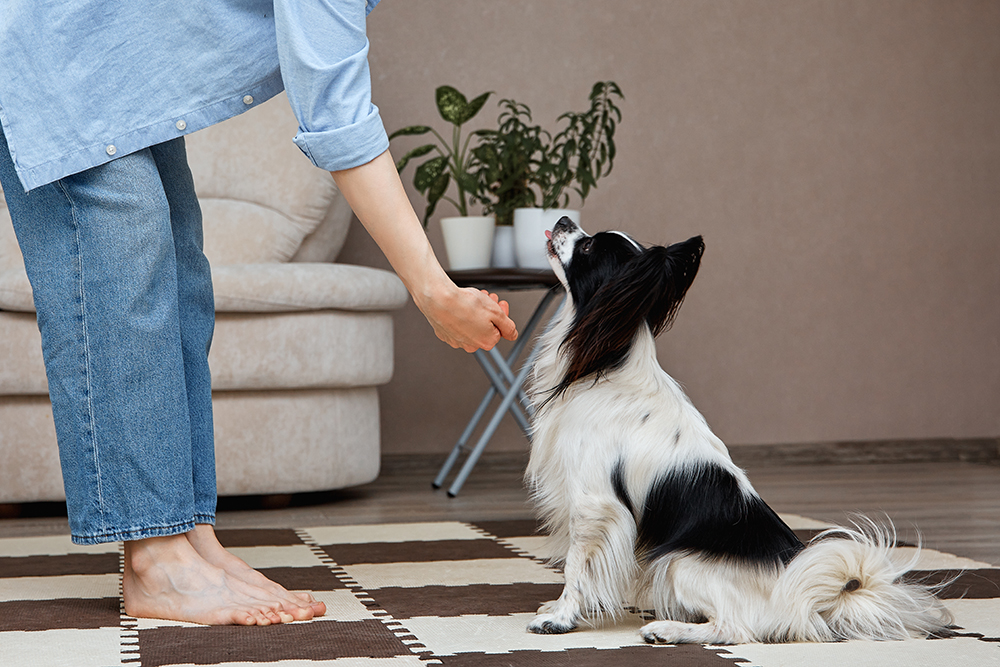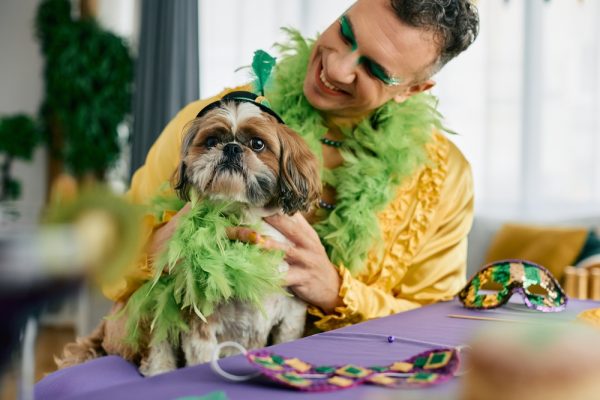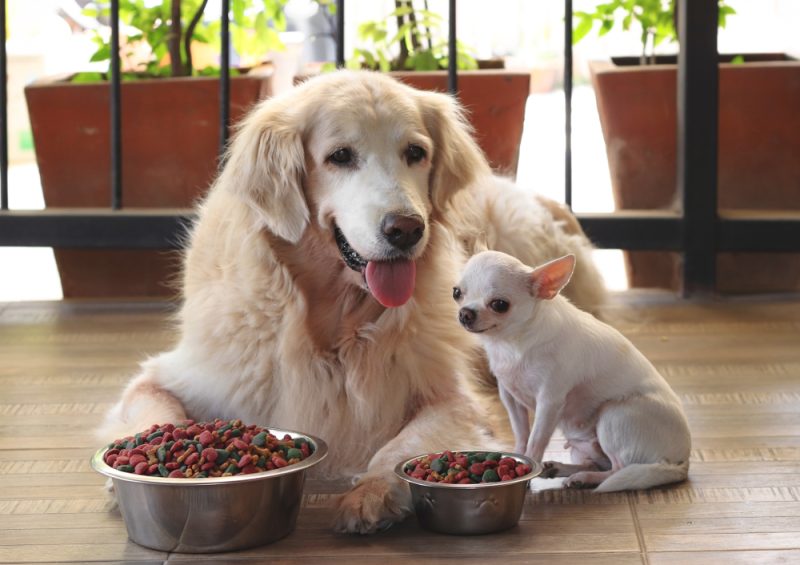In this article
View 8 More +The Papillon is a beautiful little dog with a history steeped in royalty. They’re charismatic and gentle with a big personality despite their small size. The silhouette of the Papillon is unmistakable; their large ears sitting high on their heads and covered in flowing fur make them look like butterflies, which is where the name Papillon (French for butterfly) comes from!
Breed Overview
Height:
8–11 inches
Weight:
5–10 pounds
Lifespan:
14–16 years
Colors:
White and various colors (lemon, black, red, sable, tan, brown, fawn), tricolor, red, sable, white, white and liver/silver
Suitable for:
Families comfortable with lots of grooming, singles who work from home
Temperament:
Friendly and gentle, bright, athletic, good for families with older children
Papillons have a unique look, with flowing fur cascading down from large ears. However, there’s a type of Papillon that has floppy ears; the Phalene has beautiful fur, but it lays flat against their head. The Papillon makes an excellent pet due to their bright temperament and intelligence. As one of the oldest toy breeds, Papillons have been depicted in art since the 16th century.
Papillon Characteristics

Papillon Puppies

Papillon puppies are as energetic as their adult counterparts. According to Stanley Cohen’s dog intelligence scale, Papillons are among the top 10 most intelligent dogs. Papillon puppies are fun to train but very mischievous! Their natural inquisitiveness and quick wit can encourage them to misbehave. Papillons are not hard to find since they’re popular in the US. There are many dedicated breeders of Papillons, and both Papillons and Phalenes occur in one litter!
Because of their popularity, you can also find a Papillon puppy in a rescue shelter. Crossbreeds are also common, so there’s plenty of opportunity to find the perfect Papillon puppy for your family.

Temperament & Intelligence of the Papillon 🧠
Papillons are highly intelligent and are one of the top 10 most intelligent breeds in the world! These dogs love to please, and they’re so pleasant you’ll be instantly charmed by them. They’re known for their happy dispositions and love of playing games.
They’re a pleasure to train both for obedience shows and in a more relaxed home setting. Papillons are very friendly and adore people, and they treat strangers and friends the same. They’re rather loud and are known to bark frequently without the proper training.
You’ll need to channel their energy into training and stimulation since behavioral issues can arise from boredom.

Are These Dogs Good for Families? 🏡
Papillons are excellent dogs for families, and their small stature and sunny disposition make them ideal for homes of any size. Families with children will struggle to find a better companion, but small children should always be supervised around them due to their small size.
Despite being diminutive, Papillons are a wellspring of affection and energy; active families will be surprised to see their little dog never struggling to keep up on hikes or long walks! Seniors, large families, and owners who stay home most of the time make ideal pet parents for Papillons.
Does This Breed Get Along With Other Pets? 🐶
Papillons are incredibly friendly and open and can be wary of other dogs initially. However, they’ll warm up to them eventually and become lifelong friends. Papillons also get along with cats as long as they’ve been socialized well.
Because they’re so small, Papillons seem less threatening to feline friends and adore their affection and attention almost as much as their owners. Large dog owners should be cautious when introducing a Papillon into their homes. Papillons are big dogs in tiny packages and will play rough, which could result in an accidental injury if the large dogs reciprocate.

Things to Know When Owning a Papillon
Below, we’ll discuss the Papillon’s diet, exercise, training, and grooming requirements to help you decide if they’re the breed for you.

Food & Diet Requirements 🦴
The Papillon is a little dog with lots of energy, so a high-quality food that caters to their needs is important. They’re not as susceptible to obesity as other small pups since they are so active, but keeping an eye on their diet and treat consumption (particularly when training!) can protect their joints well into old age.
Measuring out your Papillon’s food and getting the best quality you can afford will keep them trim, and it doesn’t take much to feed them, so buying in bulk will save you money.
Small-breed diets are ideal, but you can also talk to your veterinarian for feeding advice. Papillon puppies should always be fed frequently since small breeds are prone to low blood sugar (hypoglycemia), which can quickly become fatal.
Exercise 🐕
Papillons are very energetic and need to be exercised daily. Because they’re little, energetic play can provide much of their daily exercise needs. Papillons are agile and love to perform in agility courses, and dog parks with agility equipment can be an excellent way to keep them happy. Be mindful of large dogs and try to visit dog parks that have separate sections for large and small dogs.
Training 🦮
Papillons are amazing candidates for obedience trials and training since they’re smart and love to please their owners. They’re one of the most popular toy breeds for obedience and agility trials for a reason! Treats and positive training methods get the best results with the Papillon, and they take on many tasks with ease.
Papillons can make excellent therapy dogs thanks to their intelligence and sunny disposition, and they are brilliant entertainers when performing tricks in the home! Consistency is key with the Papillon, as they can sometimes get over-excited and distracted; using short sessions and always ending on a positive note can keep their attention and make the most of their canine smarts.

Grooming ✂️
The Papillon is fairly easy to groom despite being elegantly adorned with long fur. Their fur is long and silky, and while it does tangle, it only needs to be brushed twice a week. It’s a good idea to pay extra attention to a Papillon’s ears, under their legs, and their tail, as this fur is longer and more likely to tangle.
They don’t shed too much, but they are not considered “hypoallergenic.” It’s important to get your Papillon comfortable with grooming from a young age since they’ll need grooming throughout their lives. Neglecting your Papillon’s grooming can cause skin issues and painful matted clumps in their fur.
Health and Conditions ❤️
The Papillon is a fairly healthy breed compared to other pedigree dogs of the same size, but they suffer from a few health conditions you should be aware of if you’re considering adopting one into your family.
- Arthritis
- Dental disease
- Cryptorchidism/Monorchidism
- Open Fontanelle (open spot in the skull)
- Luxating Patella
- Progressive Retinal Atrophy
- Seizure disorders
Male vs Female
There are no visible differences between male and female Papillons, and both sexes are full of life and love. Both sexes can be fixed to alleviate hormone-related behaviors, and both live for the same length of time.
Some health issues only affect male or female dogs, such as testicular cancer or ovarian cancer. However, neutering and spaying can reduce the likelihood of those diseases.

3 Little-Known Facts About the Papillon
1. Marie Antoinette Is Said to Have Carried Her Pet Papillon to Her Execution at the Guillotine
This is likely just a legend, but the French royalty was well-known to love fluffy-eared dogs and depicted them in artworks. The legend of Marie Antoinette’s dog doesn’t mention what happened to the Papillon, but some theories suggest the dog only waited outside the prison where she was kept. Louis XIV and Madame de Pompadour also owned Papillons.
2. The Ancestors of the Papillon Were Spaniels Bred to Flush Birds Out of Nests or Trees as Far Back as the 1300s!
These “dwarf Spaniels” were crossed with toy breeds to develop the Papillon. Their lightning speed and hunting skills were retained by the Papillon, which is why they’re one of the fastest small dogs around.
3. Papillon Is French for “Butterfly,” and Phalene Is French for “Moth”
The Papillon is sometimes referred to as the butterfly dog, it was given this name thanks to their iconic high-set, well-furred ears that give them a silhouette similar to a butterfly. Some of the artists who helped popularize their stunning appearance include Goya, Rembrandt, Rubens, and Toulouse-Lautrec.


Final Thoughts
Papillons are a very special breed with a sunny disposition and seemingly endless energy. They make loving pets for any type of family. Papillons are always willing to learn, and they make perfect playmates for older children.
They’re also healthy dogs with only a few potential health problems. The Papillon’s hardiness and good health allow them to live happily into their late teens.
Featured Image Credit: Fayzulin-Serg, Shutterstock


















